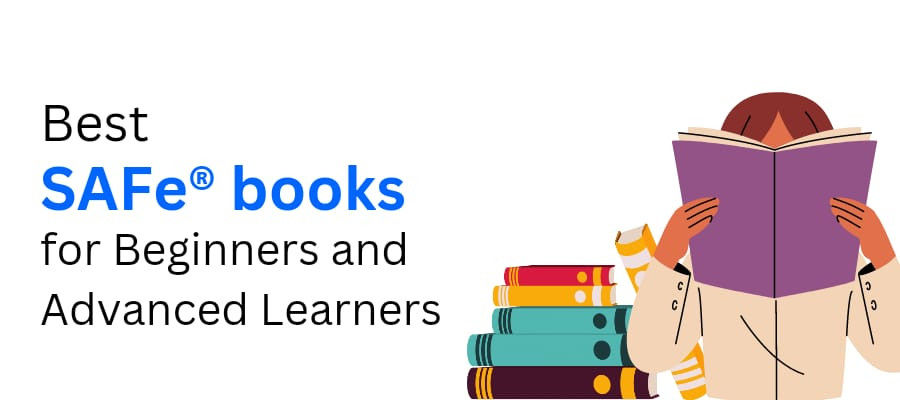Best SAFe® Books for Beginners and Advanced Learners

Effective implementation of the Scaled Agile Framework (SAFe®) in managing an entire portfolio of projects requires careful preparation and extensive knowledge. It's not an easy task that can be achieved overnight; therefore, preparation is vital. Luckily, we have compiled a list of the best SAFe® books to help you get ready for this massive shift in the right way.
These must-read entries provide an in-depth understanding of SAFe® implementation, including Agile Release Train, Program Increment Planning, process improvement, and more. By reading these books, you can learn how to apply SAFe® effectively and efficiently, making sure that your organization can achieve success in managing complex projects.
1. Distilled by Richard Knaster and Dean Leffingwell
For organizations looking to adopt the Scaled Agile Framework (SAFe®), preparation is essential. To help with this process, there are numerous SAFe® books available, but one stands out above the rest: SAFe® 5.0 Distilled by Richard Knaster and Dean Leffingwell. As the co-creator of SAFe®, Leffingwell has the insider knowledge needed to write an all-encompassing resource on the subject.
SAFe® 5.0 Distilled covers everything from SAFe® values to actionable application tips and is constantly updated to include the latest additions to the framework. With 320 pages of in-depth knowledge, SAFe® 5.0 Distilled should be required reading for anyone starting their journey with SAFe®. It's a must-have on the list of the best SAFe® books.
2. The ART of Avoiding a Train Wreck
The ART of Avoiding a Train Wreck is an excellent addition to the list of best SAFe® books for those struggling to align multiple teams in an Agile Release Train. Both authors, Em Campbell-Pretty and Adrienne L. Wilson, are seasoned SAFe® practitioners, providing valuable insight into the real-life implementation of the Agile Release Train.
The book offers practical tips and tricks to prevent mishaps and shares relatable anecdotes from keeping readers engaged. It goes beyond the standard of the SAFe® framework, making it a valuable read for anyone involved in the Agile Release Train. Moreover, it is written entertainingly, making it easy and fun to absorb information.
3. Accelerate by John K. Potter
In Accelerate, John K. Potter presents a unique approach to managing Agile projects in larger organizations. Potter introduces the Dual Operating System, a new way to reshape a company's organizational structure to facilitate Agile at scale rather than hinder it. The book focuses on specific areas of improvement, including five principles and eight accelerators that will help businesses build strategic agility for a faster-moving world.
One of the standout features of the book is the Q&A section, which provides practical tips on how to start implementing extensive structural changes to support Agile. The book's guidance is rooted in the author's extensive experience and provides a fresh perspective on how businesses can succeed in the fast-paced and constantly evolving world of modern business. If you are looking to drive change in your organization and achieve strategic agility, Accelerate is a must-read book.
4. Agile Software Requirements by Dean Leffingwell
Lean Requirements Practices for Teams, Programs, and the Enterprise is a must-read for anyone who wants to learn about creating practical software requirements in an Agile environment. In this book, Leffingwell presents a unique approach to managing requirements based on Classic, Agile, and Lean approaches that can be implemented on multiple levels, including the team, project, and portfolio.
This comprehensive resource is one of the best SAFe® books available, providing valuable insights for Developers, executives, and all other members of an organization involved in software development. With Agile Software Requirements, readers will gain a deep understanding of how to implement robust software requirements in an enterprise, making it an essential addition to any Agile Practitioner's library.
5. Lean Product and Process Development by Allen C.Ward and Durward K.Sobek II
Lean Product and Process Development, authored by Allen C. Ward and Durward K. Sobek II, is an invaluable resource for businesses adopting the Lean approach. The book provides a comprehensive overview of Lean principles, tools, and management systems, as well as guidance on developing Lean products.
Drawing on their extensive experience across various industries, the authors provide practical advice on how to streamline product development processes and eliminate waste. Readers will learn about the importance of creating a culture of continuous improvement, as well as how to implement Lean practices throughout the organization.
Whether you're a product developer, manager, or executive, Lean Product, and Process Development is an essential read for anyone looking to improve efficiency and drive innovation in their business.
Conclusion
Introducing the SAFe® methodology into the organizational structure can significantly enhance operational efficiency. The mentioned collection of the best SAFe® books can offer insight into the world of the Scaled Agile Framework and its functioning. Acquiring a profound understanding of the values that SAFe® represents is the most effective approach to implementing the SAFe® framework in a large organization.
Reference
- https://bigpicture.one/best-safe-books/



